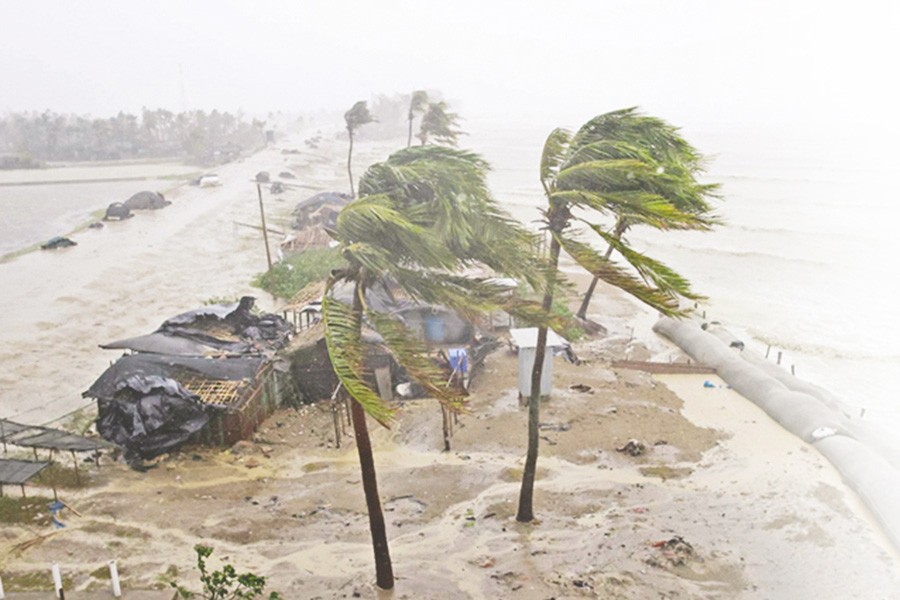
A CLOSE LOOK
The other side of deceptive season hemanta
Nilratan Halder | Saturday, 18 November 2023

The season hemanta comprising Kartik and Agrahayan on the Bangla calendar, usually cuts a low profile except for the harvest of Aman paddy and the popular agrarian festival Nabanna. It can be called an introvert season with little colour and sunshine where the self-effacing dull and grey surrounding gets the better of anything redolent with screaming bright colours. So docile a season is, however, highly deceptive and hides its violent and explosive character until it unleashes its fury once in decades or even centuries.
Yes, it is the cyclonic storm ---a few of them super cyclones that have lashed this land, the coastal areas in particular, with devastating consequences. The great Bhola cyclone that made its landfall on Bangladesh on November 12, 1970 caused the highest number of deaths and the most extensive damage ever. As many as 500,000 people and 1.0 million cattle perished in the 10.6 metre surge. This was followed by more cyclones of less wind speed and water surge of lower height around this time in different years until Sidr, a category 4 storm and rated by some as a super cyclone, struck Bangladesh coast---almost the same area that suffered from the category 3 storm in 1970---on November 15, 2007.
The funnel-like shape of the Bay of Bengal makes Bangladesh and India's eastern coasts easy targets. On that count, the unassuming hemanta appears as a menace of outsize order. Thankfully, it does not become so every other year. But for a small country with wide low-lying areas, even the less ferocious storms at this time of Aman harvest can be highly disastrous. Before the introduction of high-yielding IRRI and boro paddy, Aman and Aus were the main crops farmers cultivated and if storms damaged one of the main crops, they faced food crisis.
Cyclonic storms, however, do not make their visitations only in Hemanta or November. The century's other super cyclone Amphan could wreak havoc of stupendous proportion with life and property but mercifully it weakened before its landfall on Bangladesh coast. The Aila is yet another cyclonic storm that, like the Sidr, has left its devastating trails not for the time being but for years and decades. Many localities are yet to recover from the losses and more particularly from the abnormal changes brought about to their crop lands and means of people's livelihoods.
Amphan and Aila are summer phenomena happening in May. The water surge at that time is lower than any during the hemanta. Apparently, the cyclonic storms are particular about keeping their time, if not the date. But hasn't climate change, then, influenced such a phenomenon in a perceptible way? Apparently, it has not. Yesterday's cyclonic storm Midhili that passed Bangladesh coastal regions in the evening--- mercifully weakened --- seems to have spared Bangladesh a widespread devastation. But yet it will be costly enough for a different reason.
This reason right now may not look very decisive but it may still be an indication of what is to come. The surge of the violent sea rose up to 20-2.5 metres but its consequences were unprecedented. Many parts of Chattogram port city and Barishal went under knee-deep water. The spectre that unfolds for the future is ominous. If climate change poses the greatest threat of devouring the coastal south of Bangladesh with the rise of the sea level, this is perhaps the dress rehearsal of that cataclysmic Noah's flooding.
Today, early warning system and cyclone shelters built in the coastal areas along with volunteers deployed for evacuation of people before cyclones landfall have been saving lives. But if the entire coastal belts go under deep water for an indefinite time, there is hardly any solution to the problem. That spectre looms large on the horizone for Bangladesh. The inundation of Bhabadaha with saline water could not be solved after all these years. How can man fight the aggressive sea when it claims low-lying coastal lands? This country with an oversize population has reasons to be extremely worried because of the looming threat.
The world has witnessed unprecedented climatic developments like heat waves, heat domes, untimely floods, rains and forest fires. More such phenomena are to follow because of the failure to lower the emission of CO2 and other noxious gases resulting in temperature rise. Bangladesh is not a great polluter but those who are do not feel the urgency to go by the climate protocols. Disasters on their own backyard will perhaps prompt them to mend their ways. Until then let's keep our fingers crossed.